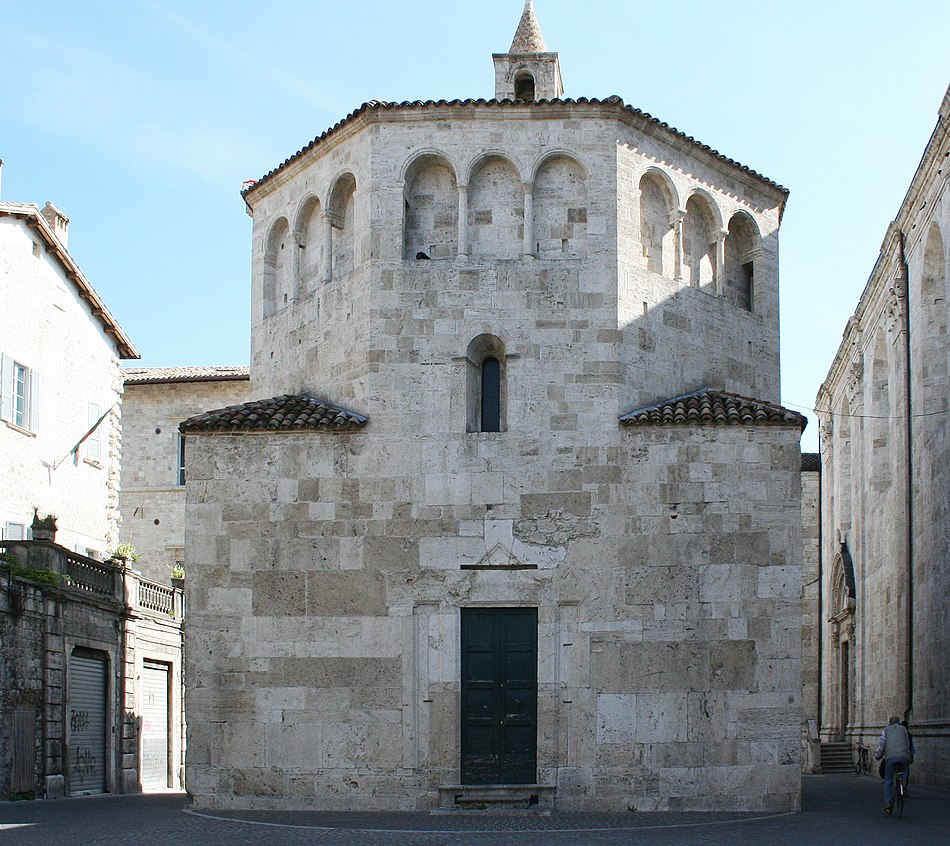
Ascoli Piceno is a comune (municipality) and capital of the province of Ascoli Piceno, in the Italian region of Marche.

The Piazza dei Miracoli, formally known as Piazza del Duomo, is a walled 8.87-hectare (21.9-acre) compound in central Pisa, Tuscany, Italy, recognized as an important center of European medieval art and one of the finest architectural complexes in the world. It was all owned by the Catholic Church and is dominated by four great religious edifices: Pisa Cathedral, the Pisa Baptistery, the Leaning Tower of Pisa, and the Camposanto Monumentale. Partly paved and partly grassed, the Piazza dei Miracoli is also the site of the Ospedale Nuovo di Santo Spirito, which now houses the Sinopias Museum and the Cathedral Museum.

In Christian architecture the baptistery or baptistry is the separate centrally planned structure surrounding the baptismal font. The baptistery may be incorporated within the body of a church or cathedral, and provided with an altar as a chapel. In the early Church, the catechumens were instructed and the sacrament of baptism was administered in the baptistery.
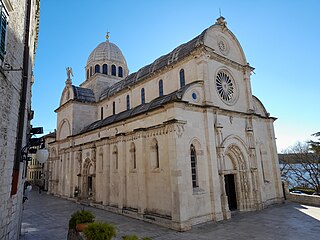
The Cathedral of St. James in Šibenik, Croatia, is a triple-nave Catholic basilica with three apses and a dome. It is the episcopal seat of the Šibenik diocese. It is also the most important architectural monument of the Renaissance in the entire country. Since 2000, the cathedral has been on the UNESCO World Heritage List.
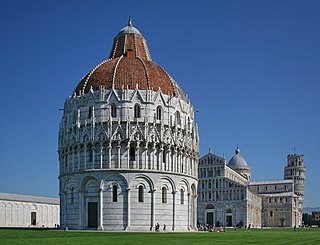
The Pisa Baptistery of St. John is a Roman Catholic ecclesiastical building in Pisa, Italy. Construction started in 1152 to replace an older baptistery, and when it was completed in 1363, it became the second building, in chronological order, in the Piazza dei Miracoli, near the Duomo di Pisa and the cathedral's free-standing campanile, the famous Leaning Tower of Pisa. The baptistery was designed by Diotisalvi, whose signature can be read on two pillars inside the building, with the date 1153.

Mantua Cathedral in Mantua, Lombardy, northern Italy, is a Roman Catholic cathedral dedicated to Saint Peter. It is the seat of the Bishop of Mantua.
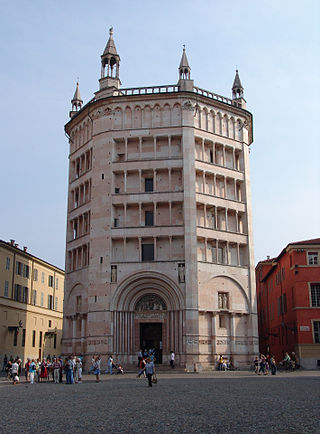
The Baptistery of Parma is a religious edifice in Parma, northern Italy. Architecturally, the baptistery of Parma Cathedral marks a transition between the Romanesque and Gothic styles, and it is considered to be among the most important Medieval monuments in Europe.

Padua Cathedral, or Basilica Cathedral of Saint Mary of the Assumption, is a Catholic church and minor basilica located on the east end of Piazza Duomo, adjacent to the bishop's palace in Padua, Veneto, Italy.

Fréjus Cathedral is a Roman Catholic church located in the town of Fréjus in the Var department of Provence, southeast France, and dedicated to Saint Leontius of Fréjus.

Piazza del Duomo is located in the heart of the historic center of Florence. It is one of the most visited places in Europe and the world and in Florence, the most visited area of the city. The square contains Florence Cathedral with the Cupola del Brunelleschi, the Giotto's Campanile, the Florence Baptistery, the Loggia del Bigallo, the Opera del Duomo Museum, and the Arcivescovile and Canonici's palace. The west zone of this square is called Piazza San Giovanni.

Palazzo dell'Arengo is a monumental palace located on Piazza Arringo, also called Piazza dell'Arengo, in the town-center of Ascoli Piceno, Marche, central Italy. The facades of the Duomo of Ascoli Piceno, the Baptistry of San Giovanni Battista, and the Episcopal palace also face the square, which is now decorated with two oval fountains.

The Ventidio Basso Theater is the communal theater, concert hall, and opera house in the city of Ascoli Piceno region of Marche, Italy. It is located on via del Trivio, in front main cloister of the church of San Francesco, near piazza del Popolo. The exterior was erected in neoclassical-style, with grand interiors.

Ripatransone Cathedral is a Roman Catholic cathedral and minor basilica in the town of Ripatransone, province of Ascoli Piceno, region of Marche, Italy. It is located on Piazza Ascanio Condivi. The cathedral is dedicated to Saint Gregory the Great and to Saint Margaret. It was formerly the episcopal seat of the Diocese of Ripatransone but is now a co-cathedral in the Diocese of San Benedetto del Tronto-Ripatransone-Montalto.

The Co-Cathedral of Saint Mary of the Assumption and Saint Catellus is the Roman Catholic duomo or cathedral of Castellammare di Stabia in the metropolitan city of Naples, in the region of Campania, Italy. It is the main church in Castellammare di Stabia and it is co-cathedral of the Archdiocese of Sorrento-Castellammare. It was built in 1587 and was consecrated in 1893. Inside on display for worship is the statue of Saint Catello, the patron saint of the city.

The Basilica di San Francesco is a Gothic-style, Roman Catholic church located on the Piazza del Popolo in the town of Ascoli Piceno in the region of Marche, Italy.
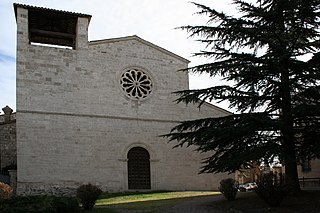
San Vittore is a Romanesque and Gothic-style, Roman Catholic church located in the town of Ascoli Piceno in the region of Marche, Italy.
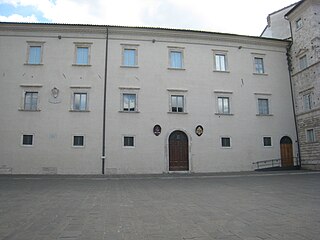
The Diocesan Museum in the Italian town of Ascoli Piceno is located in one wing of the ecclesiastical palazzo, which also contains the city's pinacoteca and the state archeological museum.

The Piazza Arringo, also known as the piazza dell'Arengo, is the oldest monumental piazza in the city of Ascoli Piceno.

Montalto Cathedral, otherwise the Basilica of Santa Maria Assunta e San Vito, is the principal Roman Catholic church of the town of Montalto delle Marche, province of Ascoli Piceno in the region of Le Marche, Italy. It is dedicated to the Assumption of the Virgin Mary. The church was formerly, from 1586, the episcopal seat of the Diocese of Montalto. When the diocese was subsumed into the present Diocese of San Benedetto del Tronto–Ripatransone–Montalto in 1986, Montalto Cathedral became a co-cathedral in the new diocese. It was created a basilica minor by Pope Paul VI in 1965.
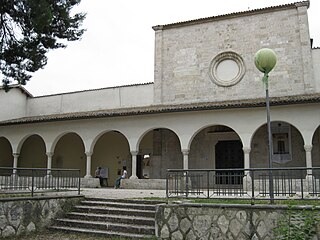
Santissima Annunziata was a Roman Catholic church dedicated to the Annunciation in Ascoli Piceno, Italy. It is located in the Parco dell'Annunziata. The whole complex was the result of extensions to an original 13th century set of buildings.

